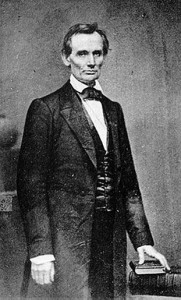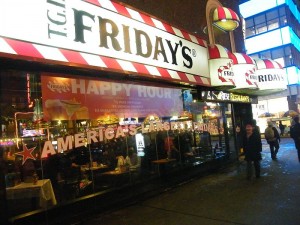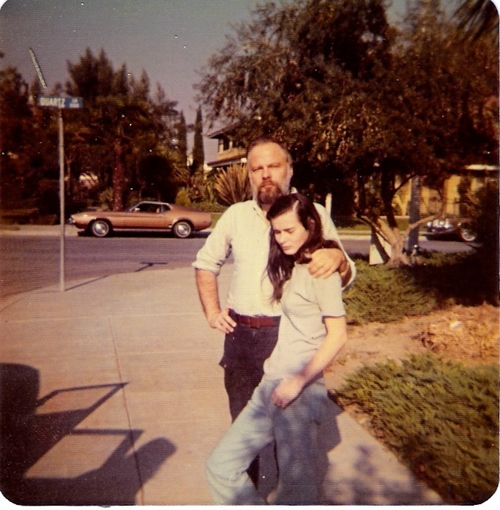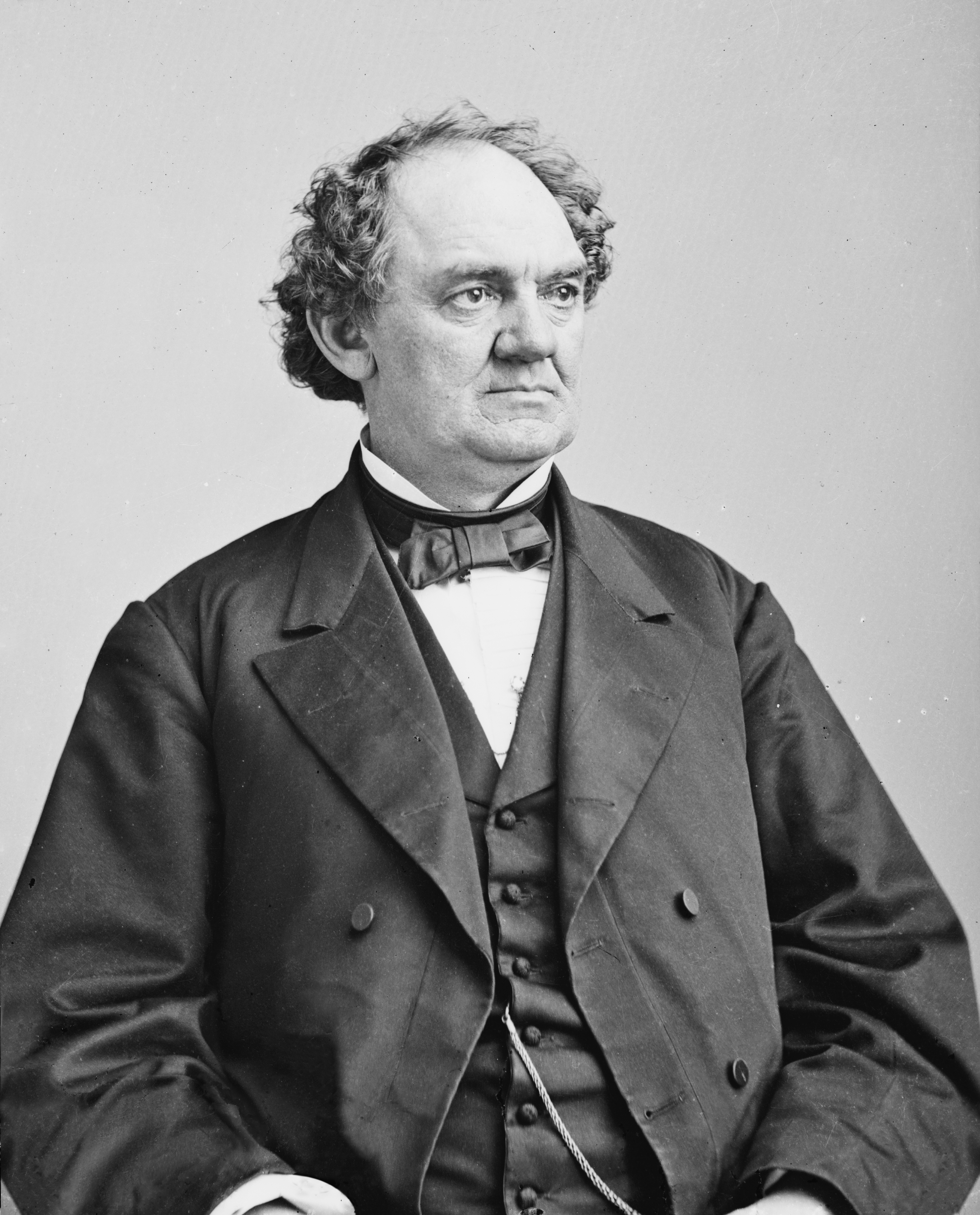Some of Gilbert Gottfried’s finest work since he played Dr. Peabody in Problem Child 3: Junior in Love. (Thanks Reddit.)
You are currently browsing the archive for the Urban Studies category.
Tags: Gilbert Gottfried
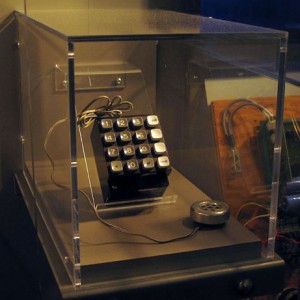
An original Blue Box at the Computer History Museum. Al Gilbertson invented the first such box, which gave callers the same control over the phone system as an operator. (Image by RaD man.)
Before the World Wide Web allowed most of the planet to be readily connected, people were already using whatever techological gadget they had at hand to try to reach out-of-the-way places and obscure information. Phone phreaks were pre-computer revolution hackers who figured out ways to place free phone calls and learn the finer points about the phone company’s computer system. For phreaks (including the pre-Apple Steves, Jobs and Wozniak), this hacking was a training ground for future endeavors in the computer industry.
The phone company was not amused, however, so these phreaks hid behind aliases like “Captain Crunch” and “Legion of Doom.” It was a subculture that few knew about until 1971, when Ron Rosenbaum’s Esquire article, “Secrets of the Little Blue Box,” profiled hacker Al Gilbertson. An excerpt:
“There is an underground telephone network in this country. Gilbertson discovered it the very day news of his activities hit the papers. That evening his phone began ringing. Phone phreaks from Seattle, from Florida, from New York, from San Jose, and from Los Angeles began calling him and telling him about the phone-phreak network. He’d get a call from a phone phreak who’d say nothing but, ‘Hang up and call this number.’
When he dialed the number he’d find himself tied into a conference of a dozen phone phreaks arranged through a quirky switching station in British Columbia. They identified themselves as phone phreaks, they demonstrated their homemade blue boxes which they called ‘M-F-ers’ (for ‘multi-frequency,’ among other things) for him, they talked shop about phone-phreak devices. They let him in on their secrets on the theory that if the phone company was after him he must be trustworthy. And, Gilbertson recalls, they stunned him with their technical sophistication.
I ask him how to get in touch with the phone-phreak network. He digs around through a file of old schematics and comes up with about a dozen numbers in three widely separated area codes.
‘Those are the centers,’ he tells me. Alongside some of the numbers he writes in first names or nicknames: names like Captain Crunch, Dr. No, Frank Carson (also a code word for a free call), Marty Freeman (code word for M-F device), Peter Perpendicular Pimple, Alefnull, and The Cheshire Cat. He makes checks alongside the names of those among these top twelve who are blind. There are five checks.
I ask him who this Captain Crunch person is.
‘Oh. The Captain. He’s probably the most legendary phone phreak. He calls himself Captain Crunch after the notorious Cap’n Crunch 2600 whistle.’ (Several years ago, Gilbertson explains, the makers of Cap’n Crunch breakfast cereal offered a toy-whistle prize in every box as a treat for the Cap’n Crunch set. Somehow a phone phreak discovered that the toy whistle just happened to produce a perfect 2600-cycle tone. When the man who calls himself Captain Crunch was transferred overseas to England with his Air Force unit, he would receive scores of calls from his friends and ‘mute’ them — make them free of charge to them — by blowing his Cap’n Crunch whistle into his end.)
‘Captain Crunch is one of the older phone phreaks,’ Gilbertson tells me. ‘He’s an engineer who once got in a little trouble for fooling around with the phone, but he can’t stop. Well, this guy drives across country in a Volkswagen van with an entire switchboard and a computerized super-sophisticated M-F-er in the back. He’ll pull up to a phone booth on a lonely highway somewhere, snake a cable out of his bus, hook it onto the phone and sit for hours, days sometimes, sending calls zipping back and forth across the country, all over the world….’
Back at my motel, I dialed the number he gave me for ‘Captain Crunch’ and asked for G—- T—–, his real name, or at least the name he uses when he’s not dashing into a phone booth beeping out M-F tones faster than a speeding bullet, and zipping phantomlike through the phone company’s long-distance lines.
When G—- T—– answered the phone and I told him I was preparing a story for Esquire about phone phreaks, he became very indignant.
‘I don’t do that. I don’t do that anymore at all. And if I do it, I do it for one reason and one reason only. I’m learning about a system. The phone company is a System. A computer is a System. Do you understand? If I do what I do, it is only to explore a System. Computers. Systems. That’s my bag. The phone company is nothing but a computer.'”
Tags: Al Gilbertson, Ron Rosenbaum
I recently posted about Abraham Lincoln’s less-than-graceful youth, using examples from Carl Sandburg’s great biography, The Prairie Years. Here’s another brief tale of Lincoln’s boorish behavior from that tome:
“He put barefoot boys to wading in a mud puddle near the home trough, pulled them up one by one, carried them to the house upside down, and walked their muddy feet across the ceiling. The stepmother came in, laughed at their foot tracks, told Abe he ought to be spanked–and he cleaned the ceiling so that it looked new.”
Tags: Abraham Lincoln
Created by farmer Wu Yulu.
Tags: Wu Yulu
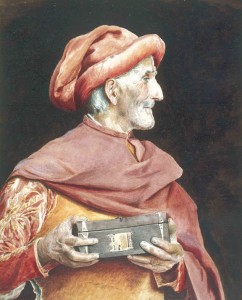
"It is alleged by his wife that he has given her but $7 in fifteen years for the needs of herself and her children." (Image by Maria Feodorovna.)
The July 19, 1896 edition of the Brooklyn Daily Eagle tells the story of miserly Maurice Flynn, who probably could have been a better husband. An excerpt:
“The miser in Balzac’s Eugenie Grandet seems too miserly to be true, but he is outdone in real life. Newark has a worse than prototype in Maurice Flynn, a rich contractor. It is alleged by his wife that he has given her but $7 in fifteen years for the needs of herself and her children, that when she was ill form overwork and asked for help he told her that she was beggar enough and poor enough to be her own servant, that he made her cook for twenty men on a skimped allowance, that when she asked for more and better food he broke her breastbone with a blackjack, while at other times he tried to hold her on a hot stove and beat her with a poker to curb her strange desire for meals. So she asks for divorce, and as her statements are corroborated she is likely to get it.”
Tags: Maurice Flynn
During his suspension from boxing for refusing to fight in the Vietnam War, Muhammad Ali appeared on a 1968 episode of William F. Buckley’s Firing Line program to discuss a myriad of issues. In the same year, Pete Hamill wrote an article about Ali’s embattled status for Life. An excerpt:
“Even before he exhausted all legal means of defense on his conviction as a draft evader, his title and livelihood were taken away. And yet Ali does not seem bitter. ‘I’m happy,’ he had said on his way to the theater, ’cause I’m free. I’ve made the stand all black people will have to make sooner or later: whether or not they can stand up to the master.'”
Player, coach and writer Walter Camp describes the “Quarter-Back” position in his 1891 book, American Football:
“The quarter is, under the captain, the director of the game. With the exception of one or two uncommon and rare plays, there is not one of any kind, his side having the ball, in which it does not pass through his hands. The importance of his work it is therefore impossible to overrate. He must be, above all the qualifications of brains and agility usually attributed to that position, of a hopeful or sanguine disposition. He must have confidence in the centre himself, and, most of all, in the man to whom he passes the ball. He should always believe that the play will be a success. The coach can choose no more helpful course during the first few days, as far as the quarter is concerned, than that of persuading him repose confidence in his men. Many promising half-backs are ruined by the quarter. There is nothing that makes halves fumble so badly, get into such awkward positions, start so slowly, and withal play so halfheartedly, as the feeling that the quarter does not think much of them, does not trust them, or believe in their abilities. When he lacks confidence in his man, his passing is unsteady and erratic as well as slow.”
Tags: Walter Camp
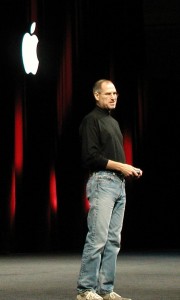
"Interracial, milf, midgets (lol), bbc, bt, bc, dp, Latin, black, some Asian." (Image by mylerdude.)
50 Adult Dvds for trade for Ipod or any smartphone or electronics – $1 (Queens)
I have 50 adult dvds for trade for anyone with an ipod 4 or 3g or any smartphone, or any other electronics in excellent and operational condition cosmetics don’t really matter as long as it works good. The dvds are mixed but the average run time is 7 hours and consist of interracial, milf, midgets (lol), bbc, bt, bc, dp, Latin, black, some asian, and one dvd by 50 cents (the rapper) among many others. All the vids are worth well over $300 and you’ll have days, upon days of self satisfaction without having to see the same material again unless you like a scene.
Tags: 50 Cent
I think. (Thanks Reddit.)
It may be difficult to believe considering the way T.G.I. Friday’s is viewed today, but the origin story of the first Friday’s restaurant in Manhattan on First Avenue and 63rd Street, which opened in 1965, is also the origin story of the singles bar in America. Founder Alan Stillman recalled his place in urban history for the New City Reader not long ago. An expanded version is now available at Edible Geography. An excerpt:
“New City Reader: Explain how you went about recreating that cocktail party atmosphere in a public space.
Alan Stillman: All I really did was throw sawdust on the floor and hang up fake Tiffany lamps. I painted the building blue and I put the waiters in red and white striped soccer shirts. If you think that I knew what I was doing, you are dead wrong. I had no training in the restaurant business, or interior design, or architecture — I just have a feel for how to use all those things to create an experience.
I wanted T.G.I. Friday’s to feel like a neighbourhood, corner bar, where you could get a good hamburger, good french fries, and feel comfortable. At the time, it was a sophisticated hamburger and french fry place — apparently, I invented the idea of serving burgers on a toasted English muffin — but the principle involved was to make people feel that they were going to someone’s apartment for a cocktail party.
The food eventually played a larger role than I imagined it would, because a lot of the girls didn’t have enough money to stretch from one paycheque to the other, so I became the purveyor of free hamburgers at the end of the month.
 I don’t think there was anything else like it at the time. Before T.G.I. Friday’s, four single twenty-five year-old girls were not going out on Friday nights, in public and with each other, to have a good time. They went to people’s apartments for cocktail parties or they might go to a real restaurant for a date or for somebody’s birthday, but they weren’t going out with each other to a bar for a casual dinner and drinks because there was no such place for them to go.
I don’t think there was anything else like it at the time. Before T.G.I. Friday’s, four single twenty-five year-old girls were not going out on Friday nights, in public and with each other, to have a good time. They went to people’s apartments for cocktail parties or they might go to a real restaurant for a date or for somebody’s birthday, but they weren’t going out with each other to a bar for a casual dinner and drinks because there was no such place for them to go.
It took off extraordinarily quickly. In the first six to nine months, T.G.I. Friday’s got written up in Time, Newsweek, and the Saturday Evening Post. Then Maxwell’s Plum opened up across the street, which was another singles bar. It was really quite a phenomenon.
I believe that the first line in the history of bars, restaurants, and discos may have been at T.G.I. Friday’s. Inside of three months, we had to hire a doorman. One night I was tending bar, and he walked up to me and said, ‘Listen, there’s a dozen people standing outside, and we have no tables and no room at the bar. What do you want me to do?” And I said, “I tell you what. Why don’t you just tell them to wait, and when someone comes out, you’ll let them in.’ He said that he didn’t know whether they would wait or not, and I said I didn’t know what else to tell him, and so he went back.
Next thing you know, I came out from behind the bar to get something and I looked outside and there were forty people standing in line. The next week we ended up buying velvet ropes. There was nothing like that anywhere else. You would either have a reservation at a fancy restaurant or you would just go into a bar or diner — nobody would wait in line for food and drink.” (Thanks Long Form.)
Tags: Alan Stillman
In addition to slaughtering his own people, how is longtime nutbag Muammar el-Qaddafi spending his time during the Libyan revolution? An excerpt from an May 2010 Q&A in the German publication Spiegel provides a hint:
“Spiegel: Where do you get your facts? Do you watch television? Do you read books?
Qaddafii: I get most of them from the Internet. I constantly sit at my computer. I read in Arabic, but now it is of course also possible to immediately get translations from English.”
“In 20 years, this technology will be mainstream…absolutely,” says Hod Lipson, roboticist at Cornell University. (Thanks Endgadget.)
Tags: Hod Lipson
Please Buy My Motherfuckin’ Jeans – $80 (TriBeCa)
I don’t know why I bought these fucking jeans. I don’t know what the fuck I was thinking. Somehow in the hazy, incandescent atmosphere of Diesel with that thumping, ear wrenching, aurally catastrophic “music” being slowly driven through my brain, I actually believed these jeans fit me. They do not. Now, nearly a month later, having tried to wear them again whilst not being intoxicated by presumptuous conceit and delusional grandeur, I have come to the conclusion that the jeans just aren’t right, they never were and they never will be. It’s truly a shame because they are really fucking cool jeans! Fo’ reals! Somebody with the correct body structure could rock the shit out of these jeans…sadly, that person is not me. And so, with a heavy heart, I would like to see these make their way into the hands of a more deserving individual, a person whose body can do justice to the high quality of build and superior materials which came into confluence, thus birthing the Viker 0088Z. The measurements of these jeans are: Men’s W26, L30. Except for trying them on in the store, they’ve only been worn once. I paid $160 for them, but I’m selling them for $80. Below is a photo of the receipt, to prove the authenticity of these motherfuckin’ jeans.
Newmark’s Door pointed me to a list of (thankfully) failed end-of-the world prognostications collected on Live Science. Here’s a particularly stupid one:
“Heaven’s Gate, 1997
When comet Hale-Bopp appeared in 1997, rumors surfaced that an alien spacecraft was following the comet — covered up, of course, by NASA and the astronomical community. Though the claim was refuted by astronomers (and could be refuted by anyone with a good telescope), the rumors were publicized on Art Bell’s paranormal radio talk show Coast to Coast AM. These claims inspired a San Diego UFO cult named Heaven’s Gate to conclude that the world would end soon. The world did indeed end for 39 of the cult members, who committed suicide on March 26, 1997.”
Tags: Art Bell
Here is the amazing Rick Rosner episode of Errol Morris’ sensational First Person TV series. Rosner is a waiter, stripper and nude model with a genius IQ, who had an unfortunate experience on Who Wants to Be a Millionaire?
Tags: Errol Morris, Rick Rosner
Long Form pointed me to a great 1993 New Republic article by Alexander Star about Philip K. Dick. An excerpt:
A heavy man with an absent smile and an intent gaze, Philip Dick typed 120 words a minute even when he wasn’t on speed, drank prodigious quantities of scotch and completed five marriages and over fifty novels before the pills and the liquor conspired to kill him at 54. His busy life has been ably narrated by Lawrence Sutin in his biography, Divine Invasions, which appeared a few years ago. Born in 1928, Dick witnessed the Depression from inside a broken home. His father, an employee of the Department of Agriculture, left the family in 1931 and went on to host a radio show in Los Angeles called This is Your Government. Dick grew up with his mother on the fringes of Berkeley’s fledgling bohemia. A troubled student, he was often “hypochondriacal about his mental condition,” as one of his wives later put it. And like many troubled boys of the time, he became a voracious reader of the science fiction pulp magazines that were then at their peak. In Confessions of a Crap Artist, a novel written in 1959, he wryly portrayed himself as an awkward kid spouting oddball ideas from Popular Mechanics and adventure stores: “Even to look at me you’d recognize that my main energies are in the mind.”•
Willie Mosconi wouldn’t go anywhere near it. (Thanks Reddit.)
This classic picture (photographer unknown) shows pedestrian traffic on the Lower East Side on Norfolk and Hester Streets in 1898. A few brief clips below from the Brooklyn Daily Eagle look at the raffish side of life on these streets during that era.
••••••••••
November 16, 1902: “Molly Marshall, 17 years old, giving her address as 327 Harrison avenue, Boston, and Solomon Rosenthal, 30, of 26 Norfolk street, Manhattan, were locked up at Police Headquarters last night as suspicious persons. The complainant is Max Singer of 24 Norfolk street, who claims to be the girl’s uncle. Singer says he received a letter two days ago from the girl’s mother, in Boston, notifying him that the girl had disappeared and that it was feared she had eloped with Rosenthal, who had not been seen since the girl’s departure. He said the woman asked him to watch New York for them.”
••••••••••
August 14, 1896: “Charles Leskowitz, 3 years old, of 113 Norfolk street, New York, was put to sleep on the fire escape on the second floor of the above house last night. Early this morning he rolled off and fell to the first floor, but was picked up a few minutes later uninjured.”
••••••••••
September 6, 1891: “Isaac Hoffer, 19 years old, who claims a residence at 58 Norfolk street, New York, was held for trial by Justice Smith at the Essex market police court yesterday charged with having stolen a baby carriage belonging to Mrs. Lina Sowden, from the hallway of her residence, 127 Rivington street. He was trying to sell it for 25 cents when he was arrested.”
••••••••••
November 22, 1890: “Joseph Thompson, charged by Frederick Wool, of 148 Norfolk street, New York, a wandering minstrel, with knocking him down, was held for examination on Monday.”
••••••••••
September 2, 1893: “Nathan Levine, 17 years old, of 32 Hester street, and Meyer Shubert, 13 years old, of 78 Norfolk street, were before Justice Meade, in the Tombs police court, New York, this morning, charged with stealing a horse and wagon belonging to Philip Ramburgh of this city. Ramburgh left the team at the Washington market for a few minutes, and when he returned it was gone. He afterward found the boys trying to sell the outfit for $20. In court this morning they were held for examination.”
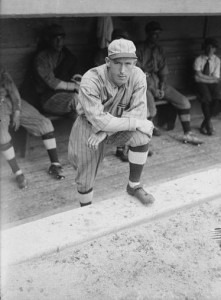
"Dirty Ball: A mean trick by a player in illegally interfering with an opposing player." (Image by Bain News Service.)
Taken from the 1892 Brooklyn Daily Eagle “Base Ball Glossary.”
- The Box: The pitcher’s position.
- Chase the Leather, or the Sphere: To run after the ball when batted to the field.
- Corker: A fast, hard hit ball sent to the field by the batsmen.
- Daisy Cutter: A ball knocked by a batsman that goes at a rapid rate through the grass.
- Died on Base: When a base runner is on a base and the third man on his side is put out.
- Dirty Ball: A mean trick by a player in illegally interfering with an opposing player.
- Fan: An enthusiast who talks base ball incessantly.
- Fumble: When a player fails to a catch a ground ball, but fumbles it after stopping it.
- Garden: The entire field.
- Hot One: When the ball, on being hit hard, travels very fast.
- Rap Out: To bat out the ball.
- Stick Work: Batting.
- Twirler: Pitcher.
- Yellow Ball: Poor playing.
Good for dog.
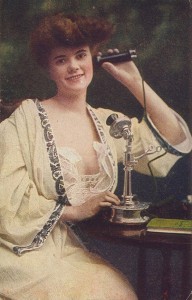
"Increases the facility with which invitations may be extended and accepted." (Image by Infrogmation.)
A print newspaper advertisement from 1899:
“Telephone service increases the facility with which invitations may be extended and accepted. Telephone service saves time, strength and nerves. Telephone service keeps members of the family in constant touch, no matter in what part of the country they may be located. Telephone service adds immeasurably to the comfort of suburban life by bringing the city within speaking distance. Residence service as low as 81 cents per week. The New York and New Jersey Telephone Company, 81 Willoughby Street, Brooklyn, New York.”
Zappa transforms a bike into a musical instrument on one iteration of the Steve Allen Show. Invaluable if crummy-looking footage. (Thanks Reddit.)
Tags: Frank Zappa, Steve Allen
Rebecca Boyle of Popsci has a post about the Transition, a plane-car hybrid that has been approved by the FAA for sale in 2012. It won’t be cheap, but it’s not as expensive as I might have imagined. An excerpt:
“Late next year, you’ll be able to buy your own flying car — er, ‘roadable aircraft’ — thanks to a thumbs-up from the Federal Aviation Administration. As long as you have $194,000 and a sport pilot license.
The agency approved the Transition plane-car this week, giving it a Light Sport Aircraft rating. The test prototype has been flying for about a year, but plane-maker Terrafugia will unveil its production-class plane next month at the Experimental Aircraft Association’s annual convention in Oshkosh, Wisc.
The Transition drives like a car, uses normal high-octane gasoline, has front-wheel-drive and even comes with airbags. Its fuel economy is about 30 miles per gallon. But unlike your Prius, it can unfold its wings and fly. You’ll only need a one-third of a mile strip for a runway, meaning you could conceivably use your own street. It is powered by a rear propeller and flies about 115 miles per hour.
The ideal customer is a sport pilot who gets tired of flying to regional regional airports only to have to wait for a cab, rent a car or use public transportation. Now he or she can just fold up the wings and motor on to the next errand.”
Tags: Rebecca Boyle


